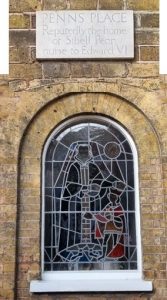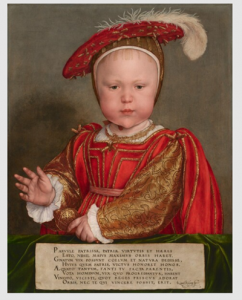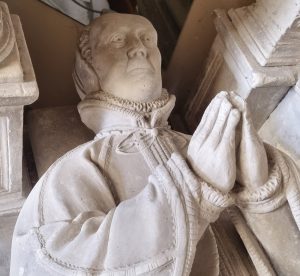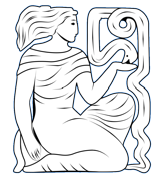| Sue Hawkins, Independent Researcher | The UKAHN Bulletin |
| Volume 10 (1) 2022 | |
I was on a bus one day travelling through Hampton in Middlesex. The bus drew to a juddering halt at temporary traffic lights (as often happens on this road) and we stopped outside a house I had never noticed before despite doing the journey many times. On the wall above a stained-glass window was a plaque which read ‘Penn’s Place. Reputedly the home of Sibell Penn nurse to Edward VI’. It is amazing how nursing history taps you on the shoulder at unexpected corners and unexpected times.

The plaque set me thinking about who this woman was and I decided to try to find out more about Sibell Penn, nurse to a future king. I should say at this point, as an historian, Tudor is most definitely not my period – the 19th century is my comfort zone, so I am heading into unknown territory here, and a lot of background reading about the Tudor court.
Over the centuries, the word ‘nurse’ has meant many things. The term could refer to a woman who earns her living by taking care of sick people, who is perhaps skilled in using natural remedies and has perhaps learnt her trade from her mother – a wise-woman. It could simply refer to someone who ‘nursed’ a sick friend or relative.[1] Or, from the late nineteenth century onwards, it could mean a trained nurse, the immediate forerunner of what we would recognise today as a professional nurse. But the term (especially in past) can also be short for ’nurse maid’ – a role more akin to a nanny. And it is often used with prefixes ‘wet’ or ‘dry’: a ‘wet’ nurse being a woman who breastfeeds babies on behalf of their mothers (now very uncommon, especially in western culture), while ‘dry’ nurses were employed once a baby was weaned, to take care of the young child, before it graduated to a governess. So, the ‘nurse’ who lived at Penn Place and acted as nurse to Prince Edward (Henry VIII’s only son, destined to become Edward VI) could have fulfilled any of these roles: as a sick nurse to the King or as a nursemaid to the young Prince. I was curious to find out..
Sibell (Sybil or Sibille– her name is spelt in several different ways in the records) Penn turns out to have been right at the heart of the Tudor Court. Penn’s Place is described as her home on the plaque, but she had another, more illustrious one, at Hampton Court Palace, just over a mile away.
Nanny, teacher and Nurse to a Prince

Sybil (I will use this spelling going forward) was from good stock. Her date of birth is unknown: some say 1515, while others say 1480 or 1482, which seems too early. Her family, the Hampdens of Hampden, Buckinghamshire, was well-connected at the Court of Henry VIII, through Sir William Sidney (or Sydney) Chamberlain and Steward to Prince Edward’s household. Sidney was probably the person who recommended Sybil to Thomas Cromwell, to fill the post of dry norrice (nurse) to one year old Edward in 1538,[2] whose mother (Jane Seymour) had died tragically, reputably as a result of infection after an attempted caesarean section.[3] There is a record of this recommendation, in which Sidney commented on ‘the good hability of my wife’s sister for the room of my Lord the Prince’s good grace’s dry norrice’.[4] While this statement has been used by some to assume that Sidney must have been Sybil’s brother in law, this seems unlikely as Sidney’s wife is well documented to be Anne Pakenham. Sidney might have been using the term ‘sister’ to imply a close family friendship, or more distant relative. Nevertheless, by his own words, the two had some connection.
The role of nurse to the baby Prince must have been daunting. By 1538 Sybil was married to David Penn (from a well-connected family of Penn, Buckinghamshire) with five young children of her own. Being tasked with the care of Henry VIII’s only and long-awaited son was obviously overladen with risk. According to some sources, she was Edward’s only nurse, but it is more likely she worked with a team including ‘under-nurses, or “rockers” of his cradle’.[5] Another source claims she slept with him every night until he was five years old.[6] Clearly, her role was a mix of nanny, teacher and nurse; and she was much approved of by King Henry who, in 1539, granted an annuity of £40 during her lifetime to ‘[David Penne and] ‘Sibille, his wife, in consideration of her services as nurse to Prince Edward, the heir apparent’.
Edward was pale and slight of build, but was not considered a sickly child. Nevertheless in 1541 danger hovered for both Edward and Sybil when the prince was struck down with a fever.[7] Fortunately, Sybil (and his other attendants) were able to nurse him through it successfully; and Henry again showed his gratitude, granting her life-rights to property in Penn, ‘in consideration of her services in the nurture and education of Prince Edward’.[8]

Sybil would have been at the centre of the extreme efforts taken to protect Edward from disease, which included washing down of walls and floors of his apartments three times a day, and she probably oversaw the preparation of his food. Edward made a complete recovery, and Henry was relieved and grateful for the care Sybil had given his precious son, giving her even more favours, granting rights (for life) to various properties in Penn village and Great Missenden also in Buckinghamshire. When Edward turned five, Sybil’s central role in his life came to an end, and his care was transferred to his male tutors, as his training to become the next King of England began. Although no longer in his household, Edward did not forget his “dry norrice”, and just before his death (in 1553 and now King), he converted the various rights for life awarded by his father, to freeholds in perpetuity.
It seems that Sybil’s ‘royal’ career did not end with the death of King Edward According to historian Charlotte Merton, as a result of her care for the young Prince Edward, she enjoyed ‘unusual favour’ with Henry’s other royal children, Mary and Elizabeth, probably working in both households.[9]
What I do know is that Sybil died (possibly from smallpox) in early December 1568, shortly after Queen Elizabeth survived her brush with the same disease – was she nursing the Queen? It isn’t clear – but whoever wrote this eulogy, which is appended to a monument to Sybil located at Hampton Church, suggests she was there!
Eulogy to Sybil Penn, from her monument at Hampton Church
‘Pen here is brought to home, the place of long a bode
Whose vertu guided hathe her shippe, in to the quyet rode
A myrror of her tyme, for vertues of the mynde
A matrone suche as in her dayes, the like was herd to find
No plant of servile stocke, a Hampden by discent
Unto whose race 300 yeres, hathe friendly fortune lent
To cowrte she called was, to foster up a King
Whose helping hand long lingering, sutes, to spedie end did bring
Twoo quenes that scepter bare, gave credit to this dame
Full many yeres in cowrt she dwelt, without disgrac or blame
No howse, ne wordly wealthe, on earthe she did regarde
Before eche joye yea and her life, her princes health prefard
Whose long and loyall love, with skilfull care to serve
Was such as did through heavenly help, her princes thanks deserve
Woolde God the ground were grafte, with trees of suche delight
That idell braines of fructfull plantes, might find just caus to writ
As I have plyed my pen, to praise this Pen with all
Who lyeth entombed in this grave, until the trompe her call
This resting place beholde, no subject place to rale
To whiche perforce ye lokers on your fleetinge bodyes shale.

And we would think that is the end of Sybil’s story. But no, it now takes a macabre twist. When the church at Hampton was renovated in the early nineteenth century her tomb was disturbed and it is said at this precise moment stories began to circulate about sightings of a ‘grey lady’ seen to walk the corridors of the State apartments and Clock Court at Hampton Court Palace. Mysterious noises are said to emanate from behind a wall in one apartment, and when the wall was removed an old much-used spinning wheel was discovered there. Accounts from later in the nineteenth century describe sightings of a ‘tall gaunt form’, identified as Mrs Penn and corresponding eerily to the effigy on her tomb (see Figure 5). Sybil Penn, or the Grey Lady, now features in Hampton Court’s ghost tours, and Sybil continues to make her presence felt.
Conclusion
Much of what is contained in this article cries out for further corroboration through more research in the archives. There are lots of ‘rumours and myths’ about Sybil, during her time as Edward’s ‘dry norrice’, but also about her connection to Queen Elizabeth, which need researching and corroborating, or otherwise debunking. I can feel myself being drawn further into a subject which remains a mystery – the call of the archives rings loud!
Sources:
Stephen Alford, Edward VI, The Last Boy King (London: Allen Lane, 2014).
Nicky Browne, Sybil Penn, Hampton Court Ghost (East Molesey, 2015).
Elizabeth Lane Furdell, The Royal Doctors 1485-1714 (Rochester, New York: University of Rochester Press, 2001).
Miles Green, Penn Parish Newsletter No.9 (June 2009). Available online at https://www.pennchurch.uk/9-monuments/ and Penn Parish Newsletter No.10 ( June 2009). Available online at https://www.pennchurch.uk/10-monuments/
Charlotte Isabelle Merton, ‘The women who served Queen Mary and Queen Elizabeth: Ladies, Gentlewomen and Maids of the Privy Chamber, 1553 – 1603’ (Unpublished PhD: Trinity College, Cambridge, 1992).
Lucy Worsley, ‘Eek! There are ghosts in my royal palace’, Daily Mail, 7 March 2015
Parish Register, St Mary’s Church, Hampton, Middlesex.
Historic Hauntings at Hampton Court Palace https://www.hrp.org.uk/hampton-court-palace/history-and-stories/historic-hauntings-at-hampton-court-palace/#gs.hnnn2u
References
[1] See Alannah Tomkins article, ‘I helpt to nurse’, elsewhere in this issue of the Bulletin.
[2] William Sidney was the father of Philip Sidney, famously one of Elizabeth I’s favourites. Nicky Browne, Sybil Penn: Hampton Court Ghost (East Molesey: 2015).
[3] Elizabeth Lane Furdell, The Royal Doctors 1485-1714 (New York: University of Rochester Press, 2001), 24.
[4] Quoted in Nicky Browne’s book, Sybil Penn, Hampton Court Ghost, but sadly not supported by a source.
[5] Stephen Alford, Edward VI The Last Boy King (London: Allen Lane, 2014), 8.
[6] This ‘fact’ is also unsourced, but is claimed, by the writer of a piece on the website run by local historians at Pen, to have emanated from Sir William Sidney’s son, who was brought up alongside the prince. https://www.pennchurch.uk/9-monuments/ [Accessed online, 15 December 2022].
[7] Like much in this article, sources to support the fact Edward suffered from fever in 1541 are hard to pin down. It is mentioned in passing by Furdell, The Royal Doctors, 44.
[8] Ibid.
[9] Charlotte Isabelle Merton, ‘The women who served Queen Mary and Queen Elizabeth: Ladies,Gentlewomen and Maids of the Privy Chamber, 1553 – 1603’ (Unpublished PhD thesis: Trinity College, Cambridge, 1992). Available online: https://www.repository.cam.ac.uk/handle/1810/251525 [Accessed on 15 December 2022)
